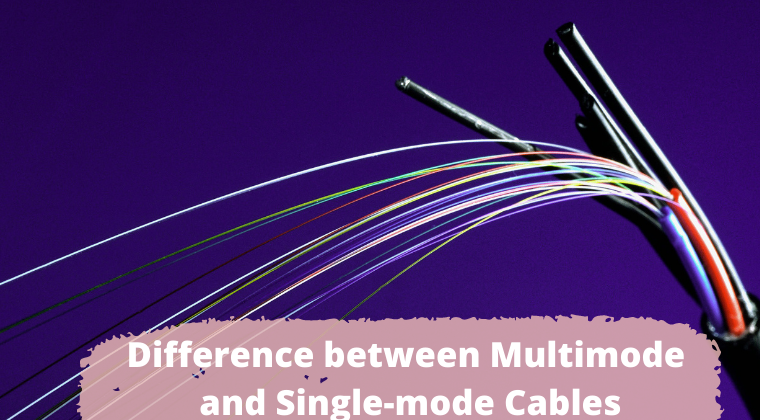Difference between Multimode and Single-mode Cables
4 min read
There is a fundamental difference in the color type of Fiber, fiber distance, and fiber cost in multimode and single mode cables. A single mode cables allows for the transmission of only one type of light mode at a time.
So, when you buy a fiber optic cable, these are the things you should be aware of and consider. The multimode wire allows light to spread in various directions. The core and length and diameter of the fiber core, bandwidth, core fiber sheath, and more, as well as the wire’s distance and cost, are the main differences between these two types of wires. However, here is a more detailed explanation of how this distinguishes the two wires:
Optical fiber refers to the glass section of a fiber optic cable that does not include any jacketing or strength members. A light-carrying core is surrounded by cladding in an optical fiber. The cladding efficiently keeps the signal traveling down the glass by preventing light from escaping the core.
A fiber with a small light-carrying core of roughly 9 micrometers (m) in diameter is a single mode cables. A human hair is closer to 100 m in length. The core is wrapped by a cladding that increases the optical fiber’s overall diameter to 125 m.
A fiber with a core length of 50 meters or more is known as multimode fiber. Multiple modes (or light rays) can pass down the core simultaneously with a more significant core. The core is wrapped by a cladding that brings the entire diameter of the optical fiber to 125 m, much like a single mode.
Core Diameter:
Because the diameter of a single mode cables is substantially less than that of a multimode cable, the multimode wire’s light gathering potential is much greater. Single-mode cables have a maximum diameter of 9 micrometers, while multimode cables have roughly 50 micrometers.
Multimode fiber has a much higher attenuation than single-mode Fiber since it takes up a lot more area in the fiber optic network connection. When purchasing a fiber optic cable, keep in mind that due to the low quantity of reflection in this cable, the attenuation in a single-mode connection is significantly reduced.
Wavelength and Light Source
Compared to more expensive light sources, you will be able to employ far more cost-effective light sources like LED in Multimode cables because they perform at an average wavelength of 850-1300 nm. It is due to the multimode cable’s huge core size, and you should remember this benefit over the single-mode cable when shopping for fiber optic cable. A laser or laser diode is frequently used to inject light into single-mode fiber cables. The most typical wavelength range for single mode cables is 1310 nm to 1550 nm.
Bandwidth:
A multimode fiber cable can offer limited bandwidth because it allows more than one light mode to pass through the cable simultaneously. In contrast, a single-mode fiber cable allows you to ensure that you are purchasing an unlimited bandwidth cable. After all, you will only be using a single light mode that can pass through the cable at a time. It is something to keep in mind when purchasing bulk fiber optic cable.
How Do you know what type of Fiber you need?
Suppose your distance is less than a few miles and your budget is less than $800. Multimode fiber optic cable is the best option in this instance since data will be transported efficiently at this distance, and your cable will not interfere with data with considerable attenuation. If the distance you need to cover is greater than 5 miles, you should consider a single-mode cable, which can cost up to $1000.
Cons of the Multimode Cable:
The attenuation is a disadvantage that you should be aware of because multimode has a higher attenuation than single-mode. One of the reasons you should be cautious when purchasing bulk fiber optic cables is this.
Cons of the Single-mode Cable:
The single mode cables will be substantially more expensive, perhaps almost twice as much as the multimode cable. When it comes to single-mode cables, this is the most significant disadvantage.
Choosing Multimode? Pick the Right Grade
Currently, multimode fiber is available in four grades: OM1, OM2, OM3, and OM4. (Incidentally, OM5 is on the way.) Each multimode fiber grade has a different capacity and distance constraint, with OM4 offering the most bandwidth over the longest distance and OM1 offering the least. Our current general grade recommendation for multimode-capable systems is OM3. As shown in the table below, OM3 offers good bandwidth-over-distance possibilities while also being more cost-effective than OM4.
It is critical to note that OM2, OM3, and OM4 all have a 50-meter core, OM1 has a 62.5-meter core.
Conclusion:
Single mode cables has a smaller core than multimode Fiber, making it more suitable for long-distance applications. In general, single-mode systems are more expensive.
Multimode fiber has a larger core than single-mode Fiber and is recommended for fiber lines under 400 meters in length (1300 feet). The grade of multimode Fiber affects its distance and bandwidth capacities. Multimode systems are less expensive in general. Cables, connections, and electrical components are all examples of this.
Make sure you know what you’re looking for with any cable you choose. The most important factors to consider are the usage, bandwidth requirements, distance, and, of course, the cable’s cost.





